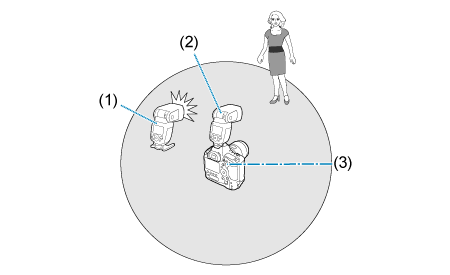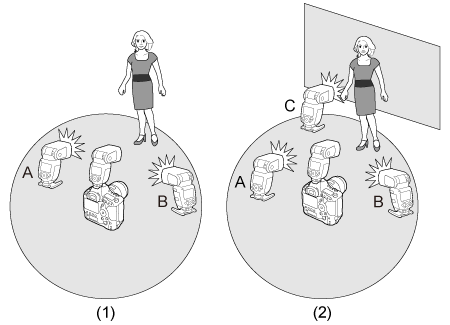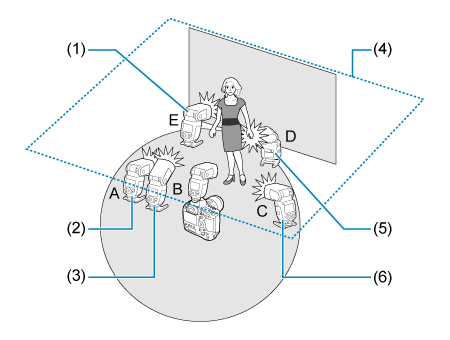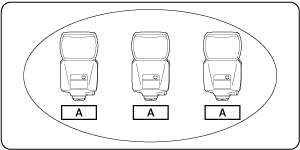Radio Transmission Wireless Flash Shooting
- Positioning and Operation Range
- Difference between Radio Transmission and Optical Transmission
- Group Control
- Restrictions on Functions Depending on the Camera Used
Using a Canon Speedlite with a radio transmission wireless shooting function, you can easily perform wireless multiple flash shooting in the same way as normal E-TTL II / E-TTL autoflash strobe photography.
The system is designed so that the settings of the EL-1 (sender unit) are automatically applied to the wirelessly controlled Speedlite (receiver unit). Therefore, you do not need to operate the receiver unit during shooting.
Positioning and Operation Range
-
Automatic Flash Photography with 1 Flash Receiver ()

(1)
EL-1
(2)
EL-1
(3) Transmission distance: Approx. 30 m / 98.4 ft.
-
Automatic Flash Photography with Receivers divided into Groups (, )
You can divide the receiver units into two or three groups and perform E-TTL II / E-TTL autoflash shooting while changing the flash ratio (flash output rate).

(1) 2 (A, B) groups
(2) 3 (A, B, C) groups
Caution
Note
- Using the mini stand provided with the receiver unit, position the receiver unit.
-
Shooting in a Different Flash Mode for Each Group ()

The flash mode settings are indicated only as an example.
(1) E-TTL II
(2) E-TTL II
(3) Manual flash
(4) Ceiling
(5) Manual flash
(6) Manual flash
Difference between Radio Transmission and Optical Transmission
Wireless shooting using radio transmission provides some advantages over wireless shooting using optical transmission, such as less interference from obstacles and not having to point the receiver's wireless sensor toward the sender unit. The main functional differences are as follows.
| Function | Radio transmission | Optical transmission | |
|---|---|---|---|
| Transmission distance | Approx. 30 m / 98.4 ft. | Approx. 15 m / 49.2 ft. (indoors) | |
| Firing group control | Up to 5 groups *1 (A, B, C, D, E) |
Up to 3 groups (A, B, C) |
|
| Receiver control | Up to 15 | No restriction | |
| Channel | Auto, Ch. 1 - 15 | Ch. 1 - 4 | |
| Wireless radio ID | 0000 - 9999 | – | |
| Receiver controls | Test flash | ○ | – |
| Modeling flash | ○ *2 | – | |
| Release | ○ *3 | – | |
1-3: Restrictions exist depending on the camera (*1: Restrictions on Functions Depending on the Camera Used, Shooting in a Different Flash Mode for Each Group, *2: Test Flash / Modeling Flash from a Receiver Unit, *3: Remote Release from a Receiver Unit).
Group Control
Firing group A

If you need more flash output or wish to perform more sophisticated lighting, you can increase the number of receiver units. Simply set an additional receiver unit to the firing group (A, B, or C) whose flash output you want to increase.
For example, if you set a firing group with three receiver units to , the three units are treated and controlled as a single firing group A with a large flash output.
Caution
- To fire the 3 firing groups A, B and C together, select
. With the
setting, firing group C does not fire.
- If you shoot with firing group C pointing directly toward the main subject, overexposure may result.
Note
- The flash ratio of 8:1 to 1:1 to 1:8 is equivalent to 3:1 to 1:1 to 1:3 (1/2-stop increments) when converted to the number of stops.
Restrictions on Functions Depending on the Camera Used
Depending on the camera, functions in radio transmission wireless strobe photography may be limited.
-
EOS DIGITAL cameras released in and after 2012
When using the flash with EOS DIGITAL cameras released in and after 2012, you can shoot without any restrictions on the flash mode and flash synchronization speed, etc.
Although EOS REBEL T100/4000D/3000D, EOS REBEL T7/1500D/2000D, EOS REBEL T6/1300D and EOS REBEL T5/1200D were released after 2012, restrictions on functions are the same as with EOS DIGITAL cameras released up to 2011 (See the following explanation for details).
-
EOS cameras compatible with E-TTL and released up to 2011
When using the flash with the cameras listed below, radio transmission wireless shooting using E-TTL autoflash is not possible. Use manual flash () or optical transmission wireless strobe photography ().
EOS-1Ds, EOS-1D, EOS-1V, EOS-3, EOS Elan II/Elan II E/50/50E, EOS REBEL 2000/300, EOS REBEL G/500N, EOS REBEL XS N/REBEL G II/3000N/66, EOS IX, EOS IX Lite/IX7
Also, when using the flash with an EOS DIGITAL camera or EOS film camera released up to 2011, the following restrictions apply.
-
(1) The maximum flash synchronization shutter speed is one step slower.
Check the maximum flash sync shutter speed (X = 1/*** sec.) of your camera and shoot with a shutter speed up to 1 stop slower than the maximum flash sync shutter speed (Example: At X = 1/250 seconds, radio transmission wireless strobe photography is possible within a range of 1/125 to 30 seconds.).
If you lower the shutter speed by one step from the maximum flash synchronization shutter speed, the
warning icon will disappear.
- (2) High-speed sync shooting is not possible.
- (3) Group firing () is not possible.
- (4) Modeling flash from the receiver () and remote release from the receiver () are not possible.
- (5) It cannot be used as a "receiver camera" during linked shooting (). It can only be used as a "sender camera".
-